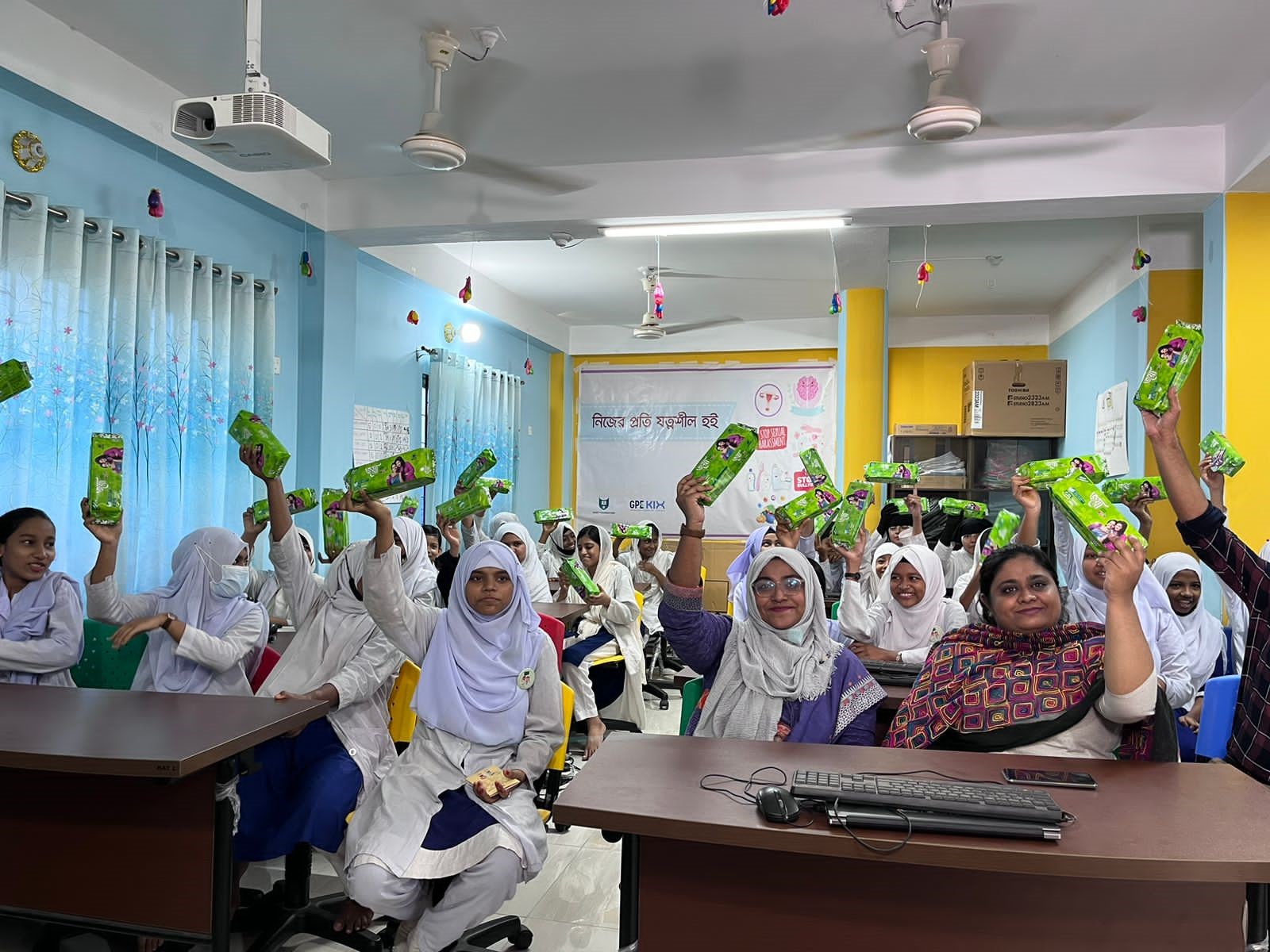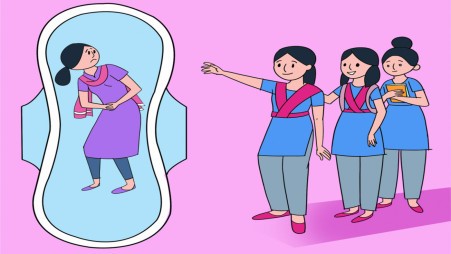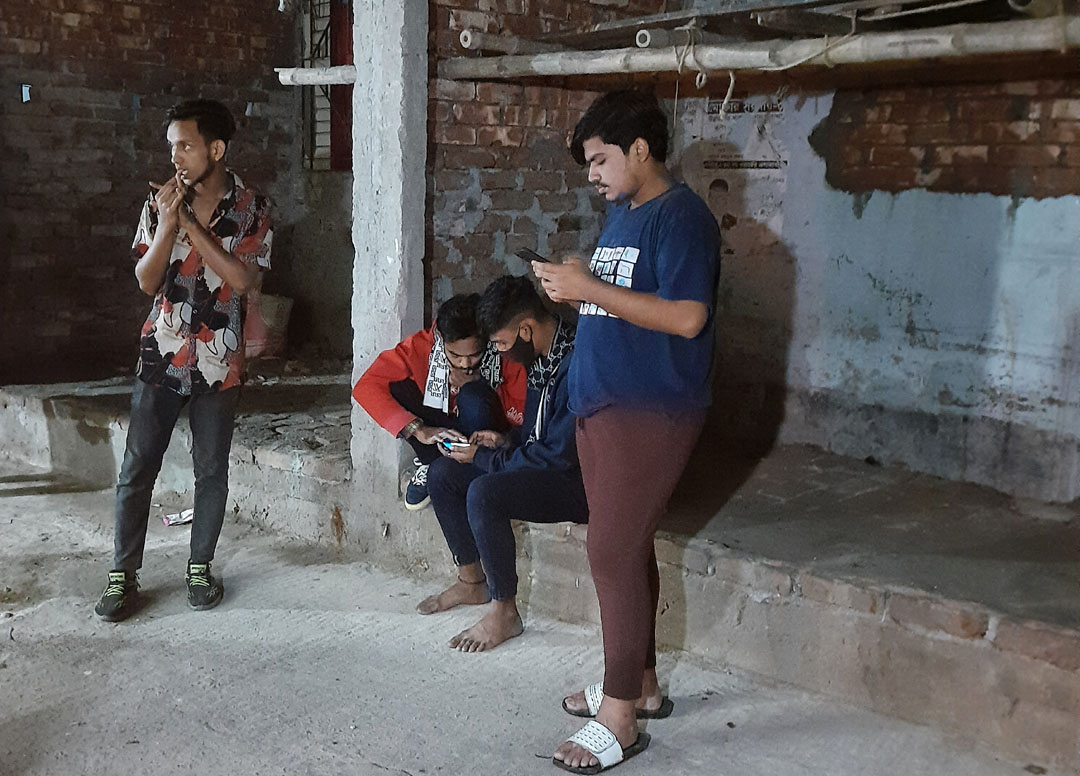SAIST Foundation, a non-profit organization, working towards preventing absenteeism, and promoting the well-being and education of school students in marginalized communities conducting a longitudinal study on “Effectiveness and Scalability of students who are out of school and at risk of dropping out in Bangladesh”, supported by IDRC and GPE KIX. To prevent absenteeism due to menstrual issues and hygiene management in schools, SAIST Foundation recently organized a series of comprehensive menstrual hygiene sessions for school girls in the study areas. These sessions aimed to address the critical issue of menstrual health and hygiene among adolescent girls, as well as to encourage them to continue schooling overcoming the barricades.
From the baseline study among 295 secondary school going students, 87.42% of female students are menstruating, about 45% miss school at least for the first 2 days of the monthly cycle in general, and around 10% of girls prefer not to attend classes for the whole menstruating days. Importantly, most girls explained their absences because of discomfort, sickness, shyness, or to avoid embarrassing mishaps in class. Even though many girls knew menstruation is a normal physiological process, they lacked knowledge of the menstrual cycle and basic menstrual hygiene.Consequently, they felt shy, scared, embarrassed, and considered menstruation as a taboo. Furthermore, 36% of them considered menstruation is not a normal physiological process. Surprisingly more than half of them perceivedthat the source of menstrual blood is the abdomen, whereas only 15% knew this information correctly. However, the majority of the female students answered correctly the question regarding the duration and cycle of menstruation, while one-fifth of them still possessed poor menstrual knowledge.
From June to August 2023, menstrual hygiene sessions were conducted with the aim of providing a safe and inclusive learning environment to offer essential knowledge about menstrual hygiene management among female students. The sessions covered various aspects, including menstrual cycle education, proper sanitary product usage, hygiene practices, and the importance of self-care during menstruation. The sessions were conducted by experienced public health professionals and educators specializing in women's health to ensure that the information imparted was accurate and evidence based. To make the sessions effective and fruitful, both theoretical discussion and practical demonstrations, with hands-on training were incorporated. At the end of every session, the foundation also distributed menstrual hygiene kits to ensure that each participating girl had access to safe and effective menstrual hygiene products.
More than 129 girls from grade six to nine of the secondary schools attended the sessions. Participating students, teachers, and school staff provided overwhelmingly positive feedback. Additionally, these sessions were appreciated by the school committees as a crucial step towards breaking the stigma revolving menstruation and promoting gender equality in education. Hence, the SAIST Foundation with their research and innovation division is continuously working for the development of health and wellbeing as well as ensuring sustainable inclusive education for marginal population.
Over the years, the government of Bangladesh has taken many initiatives and interventions to encourage girls to return to school. However, hardly any attention is paid to absenteeism that occurs during a girl's menstruation period every month. After COVID-19 pandemic schools have restarted with extra classes to cover up the learning gaps and it is high time to address the menstrual health and hygiene-related taboos, raise awareness, and provide facilities to ensure proper learning outcomes and presence at school.
According to a study “Menstrual hygiene practices and school absenteeism among adolescent girls in Bangladesh” in many lower-income communities, 41% of adolescent girls who reach menarche are missing classes an average of 2.8 days in every menstruation cycle due to the lack of knowledge, proper facilities and menstrual management support at school.
In an ongoing baseline survey of a project of IDRC and KIX, titled Effectiveness and Scalability of Programs for Children who are Out of School and At Risk of Dropping Out in Nepal, Bhutan, and Bangladesh, it is found that among 295 secondary school students, 87.42% students are menstruating and about 45% students are being absent from school for at least the first 2 days of the monthly cycle in general and about 10% girls prefer not to attend school for the whole menstruating days. Most girls explain their absences as a result of discomfort, sickness, shyness, or to avoid embarrassing mishaps in class. Despite the fact that many girls know menstruation is a normal physiological process, they lack knowledge of the menstrual cycle and basic menstrual hygiene. The majority of adolescent girls do not have prior knowledge about menstruation, and they feel shy, scared, embarrassed, and consider it taboo. 36% of them think that menstruation is not a normal physiological process. About 55% answered that, the source of menstrual blood is abdomen, whereas only 15% could answer it correctly. Regarding the duration and cycle majority of the students answered correctly. But a considerable number of students (19.67%) think that the duration is of 3-4 days, which explains their lack of menstrual knowledge.
One of the study schools even lacks separate toilets for female students, and other schools lack hygiene materials and available services for students. The toilets at some schools have open baskets in the common area where the students can dispose of their menstrual pads, but students do not feel comfortable disposing of their pads in those spaces. While collecting data, a few girls mentioned that they were advised not to dispose of pads in the bins. It is alarming that because of the lack of privacy and the ineffective management system, above 95% girls do not change their pads during long school hours. Because of the tendency to avoid the school toilets during periods, there is a tendency for students to be absent from school. The schools do not have a proper disposal system for sanitary pads, so girls who have to change them during school hours dispose of them in toilet pans, in open spaces such as drains, or carry the used pads back to their homes until they can dispose of them.
The fact that most girls are using sanitary pads is an encouraging sign. However, some girls still use old or new clothes or tissue, which should be cleaned and dried properly to prevent urinary tract infections. Above 80% of the students use sanitary napkin, while around 7% of the students still use old clothes. Typically, sanitary pads must be changed every 3 to 6 hours, depending on the flow, to avoid irritation and health risks. There is also the issue of sanitary pads not being eco-friendly, and the possibility of infection being spread if they are thrown into the environment if they are not disposed of correctly. Another significant issue that came to light in the survey is that many girls avoid fish, eggs, and sour fruits during their periods. However, a balanced diet is actually very crucial for the effective management of Pre-menstrual syndrome (PMS) symptoms.
Menstrual hygiene knowledge and practice are crucial for maintaining good health and preventing absenteeism among girls and women. Menstruation is a natural process, but a lack of knowledge and inadequate menstrual hygiene practices can lead to several health problems and negatively impact academic performance. According to the World Health Organization (WHO), poor menstrual hygiene can lead to vaginal infections, urinary tract infections, and cervical cancer (WHO, 2015). In addition, girls who do not have access to sanitary products may be more likely to use unhygienic materials, such as cloth or paper, which can further increase the risk of infection.
To conclude, girls' school absence is increased by negative attitudes, incorrect beliefs about menstruation, and inadequate school facilities. Bangladeshi girls hardly talk about their periods freely, despite the fact that they are an important part of the transition from girlhood into womanhood. This is critically imperative to end period stigma and to prevent girls from dropping out of school because of it. In addition, male students and teachers are needed to be more sensitive and knowledgeable about menstrual hygiene to create a healthy and encouraging environment in schools.
Online gaming has been increasing at an alarming rate among the school children in Bangladesh since the outbreak of COVID-19. The pandemic has forced many schools to close and shift to online learning, leaving students with more free time on their hands. This, coupled with the accessibility of smartphones and internet, has led to a surge in the number of children engaging in online gaming.
According to a study conducted by the Bangladesh Association of Software and Information Services (BASIS), the number of online gamers in Bangladesh has increased by 20% since the pandemic began. The study also found that 70% of these gamers are school-aged children.
Another study by the Bangladesh Computer Council (BCC) found that the average daily time spent on gaming by school children has increased by 30% during the pandemic. The BCC also reported that the majority of these children are playing multiplayer online games, such as PUBG and Free Fire.
The increase in online gaming has raised concerns about the impact on the academic performance of school children. A survey conducted by the Bangladesh Open University found that 30% of students who play online games regularly are struggling with their studies. The survey also found that these students are more likely to experience symptoms of depression and anxiety.
Despite the negative effects, many parents in Bangladesh are not aware of the risks of excessive online gaming. A survey conducted by the Bangladesh Telecommunication Regulatory Commission (BTRC) found that only 20% of parents in Bangladesh have set limits on their children's online gaming.
In the baseline survey of an ongoing project of IDRC and KIX, titled Effectiveness and Scalability of Programs for Children who are Out of School and At Risk of Dropping Out in Nepal, Bhutan, and Bangladesh, alarming facts have been discovered. Fahim, a student of class 7 from Control School 1, in his interview, said that his mother does not allow him to play outside. Instead, she bought him a mobile phone. To quote him “Mom does not want me to play or go outside. So, I asked her to buy me a phone to play games.” According to him, he spends 5-6 hours playing Free Fire. One of the enumerators, while interviewing a female participant of class 3, has seen her elder brother (11-13years), started playing free fire just after waking up in the morning.
Participants, especially boys are found to sleep late at night, when asked about their sleep routine. When asked what they do at the nighttime, almost half of them replied that they play games at night. Each match takes 20-30 minutes to play. And playing only one match can never satisfy the teenagers nowadays. Sohel, another participant of class 8 from Treatment School 1 in his interview said that, in one sitting he plays 4 or 5 matches at a time.
So, it means, if a person is playing at least 3 matches at a time before sleeping, he is spending 1.30 hours straight, which can make it harder to fall asleep, eventually reducing the quality of sleep and also the amount of deep-stage sleep.
Safin, from Control School 2, provided the enumerators with the fact, his classmate, encouraged him to download the game PUBG to play with him. He now prefers online games more than playing outside.
Nevertheless, online games have reduced the interest of children to play outside. It made them more confined inside the walls of their room, more precisely inside the blue screen of the online gaming world. Most of the parents, however, are unaware of this fact. To some extent, some of them feel relieved that their children are safe inside the house, as they are working outside, and their children remain alone at home most of the time. So, they might be thinking that, playing games inside house is safer than going outside, considering the current situation of the safety and securities.
In conclusion, online gaming has become alarmingly popular among school children in Bangladesh since the outbreak of COVID-19. This trend is driven by the increased availability of smartphones and internet access, as well as the closure of schools due to the pandemic. While online gaming can be a fun and entertaining activity, excessive gaming can have negative effects on academic performance, mental health, and overall well-being of children. It is important for parents and educators to be aware of this trend and take steps to set limits on children's online gaming.
In recent years, Bangladesh has seen a disturbing trend of increasing teenage gang activity among school children. This trend has been exacerbated by the COVID-19 pandemic, which has forced many schools to close and shift to online learning, leaving students with more free time on their hands.
According to a report by the Bangladesh Police, the number of teenage gangs in the country has increased by 40% since the pandemic began. The report also states that these gangs are becoming increasingly violent, with a rise in the number of assaults and robberies committed by teenage gang members.
Another study conducted by the Bangladesh Institute of Peace and Security Studies (BIPSS) found that the majority of teenage gang members in Bangladesh come from low-income families and have a history of truancy or dropping out of school. The study also found that these children are more likely to have experienced trauma or abuse in their lives.
In an ongoing baseline survey of a project of IDRC and KIX, titled Effectiveness and Scalability of Programs for Children who are Out of School and At Risk of Dropping Out in Nepal, Bhutan, and Bangladesh, teenage gang related activities of school going children have been observed. In one area, an incident has been reported that took place within the school campus. A boy of class 7 was beaten near to death by a group of his classmates and left unconscious inside the school lift. This incident went up to filing a complaint, police came in the school and the guardians were furious.
While collecting data, mother of a student, expressed her concerns regarding the safety, security of their children as well as the degrading environment of both school and nearby localities. She shared the fact that his son fell into bad company and did a lot of damage to his studies. He used to hang out with a group of boys, who took drugs. These boys would hang out in someone’s house, where the parents are working, and they are out the whole day. They would take drugs, smoke inside the house in a housing area under the control area 1. Later on, her son was brave enough to tell everything to police and the group was caught red-handed by the police. Yet his mother is now worried about the security of his son and the other children.
Two police incidents in one area, related to the same school students reflects the fact that, the increase in teenage gang activity has raised concerns about the impact on the safety and well-being of both the children involved and their communities. The Bangladesh Police have reported that teenage gangs are often involved in drug trafficking, extortion, and prostitution, which can lead to serious social problems. Additionally, children who are involved in gangs are at a higher risk of being exposed to violence and crime, which can have long-term effects on their mental health and well-being.
The government of Bangladesh has taken some steps to address this issue by increasing police patrols in areas known for gang activity and providing social services to at-risk youth. However, more needs to be done to address the root causes of this trend, such as poverty and lack of access to education and social services.
In conclusion, the alarmingly increasing trend of teenage gang activity among school children in Bangladesh after COVID-19 is a cause for concern. This trend is driven by factors such as poverty, lack of access to education, and trauma or abuse. It is important for the government, parents and educators to be aware of this trend and take steps to prevent children from getting involved in gangs, by providing them with the necessary support and resources.




